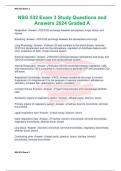NSG 532 Exam 3
NSG 532 Exam 3 Study Questions and
Answers 2024 Graded A
Respiration -Answer- ✔O2/CO2 exchange between atmosphere, lungs, blood, and
tissues
Breathing -Answer- ✔O2/CO2 exchange between the atmosphere and lungs
Lung Physiology -Answer- ✔obtains O2 and transfers to the blood stream, removes
CO2 from bloodstream and into the atmosphere, regulation of Acid/base balance with
CO2, production of ACE, innate immune system
External respiration -Answer- ✔O2/CO2 exchange between atmosphere and lungs, and
O2/CO2 exchange between lungs and cardiovascular system
Internal Respiration -Answer- ✔Includes O2/CO2 exchange between capillaries, cells,
and mitochondria, O2 is consumed in mitochondria to generate ATP and unwanted CO2
will leave.
Angiotensin Convertase -Answer- ✔ACE, enzyme created by the lungs to convert
Angiotensin I to Angiotensin II for the purpose of vascular constriction, aldosterone
secretion, increase Na+ reabsorption, and K+ excretion
Innnate Immune Function -Answer- ✔Type II pneumocytes and macrophage dendritic
cells
Accessory organs of respiratory system -Answer- ✔Nasal cavity, pharynx, larynx
Primary organs of respiratory system -Answer- ✔trachea, bronchi, bronchiole, terminal
bronchioles
upper respiratory tract -Answer- ✔nasal cavity, pharynx, larynx
lower respiratory tract -Answer- ✔Trachea, bronchi, bronchioles, terminal bronchioles,
respiratory bronchioles, alveolar ducts, alveoli
lung tissue -Answer- ✔bronchi, bronchioli, terminal bronchioles, respiratory bronchioles,
alveolar ducts, alveoli
Conducting zone -Answer- ✔nasal cavity, pharynx, larynx, trachea, bronchi,
bronchioles, terminal bronchioles
NSG 532 Exam 3
, NSG 532 Exam 3
Respiratory Zone -Answer- ✔Respiratory bronchioles, alveolar ducts, alveoli
Purpose of Conducting zone -Answer- ✔air passes into and out of lungs, no O2/CO2
exchange humidifies, warms, and filters air mucous traps and particles and cilia moves
away, adjusts pH
Purpose of respiration zone -Answer- ✔site of O2/CO2 exchange with the blood,
respiratory bronchioles and alveolar ducts are responsible for approx 10% of gas
exchange 90% is the alveolar sacs.
Functional Anatomy of alveoli -Answer- ✔located in the respiratory zone of the lungs
and ends of the alveolar ducts and alveolar sac, are the functional unit of breathing and
O2/CO2 exchange
alveolar cells -Answer- ✔fibroblasts, phagocytes, type I pneumocytes, type II
pneumocytes
Fibroblasts -Answer- ✔produce large quantities of extracellular matrix components -
elastic and collagen
Phagocytes -Answer- ✔"dust cells" destroy foreign, unwanted particles, and microbes
Type I pneuomocytes -Answer- ✔approx 90-95% of air blood barrier, O2/CO2 exchange
between the alveoli and blood are unable to proliferate
Type II pneuomocytes -Answer- ✔approx 5% of alveolar surface, secrete alveolar
surfactant to increase the alveolar capability of gas exchange, proliferate and
differentiate into type I, H20 & Na+ reabsorption
elastic fibers -Answer- ✔highly flexible for stretching and recoiling, allow the alveoli to
stretch during inhalation and spring back during exhalation
collagen fibers -Answer- ✔stretch resistant fibers, important for resisting extra elastic
forces
Parietal -Answer- ✔attached to chest wall
Visceral -Answer- ✔attached to lung
cavity -Answer- ✔where lung sits
intrapulmonary space -Answer- ✔760mmHg at rest - same as atmosphere
intra pleural space -Answer- ✔4 mmHg less - always
NSG 532 Exam 3




